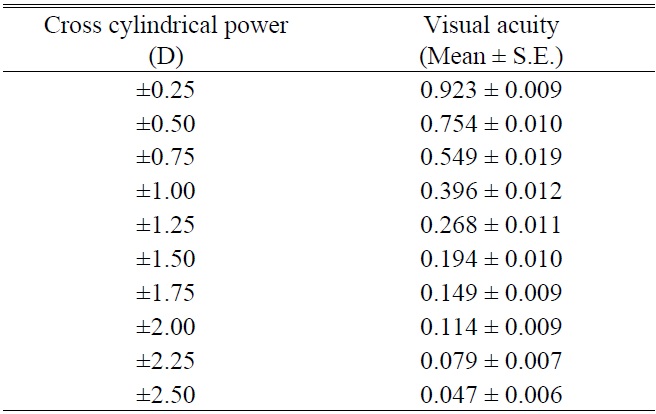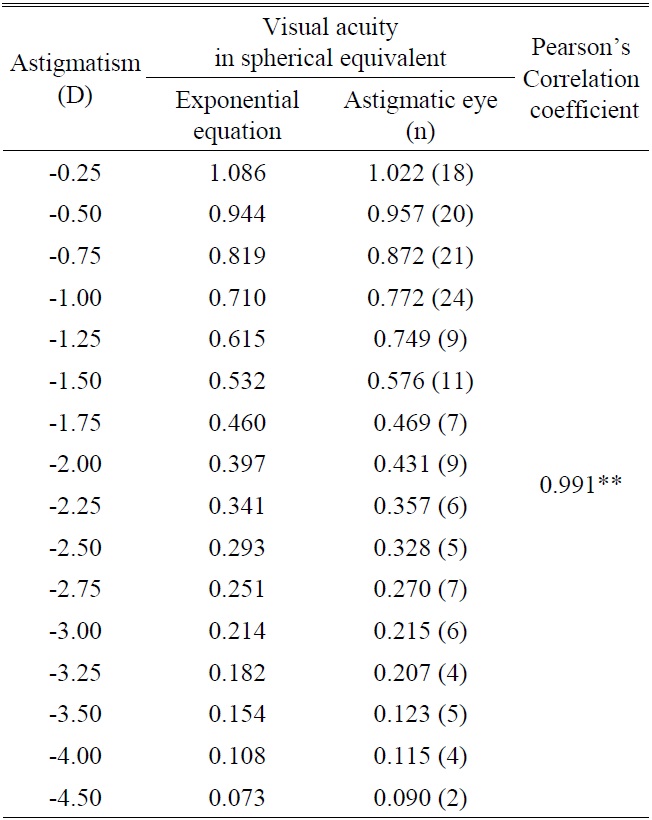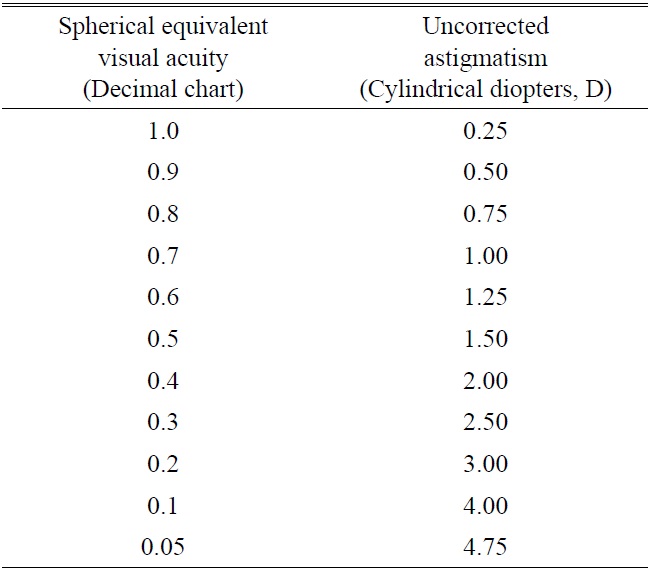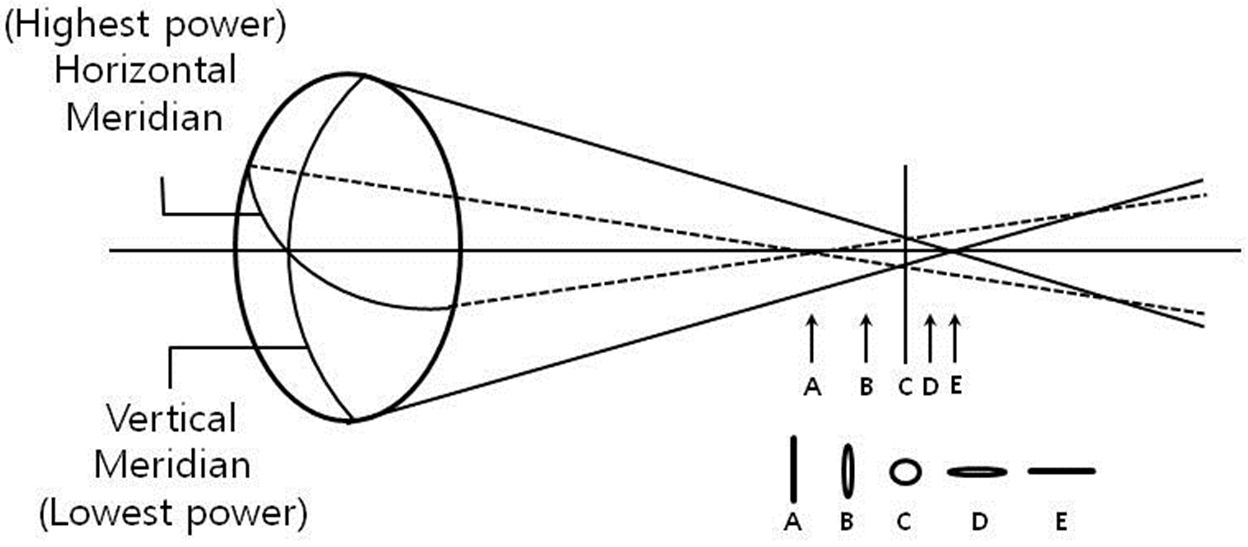



The purpose of this study was to determine the relationship between the spherical equivalent visual acuity (VA) and uncorrected astigmatism. On 108 emmetropic eyes, the spherical equivalent VA was measured for cross cylindrical lens (CC lens)-induced astigmatic eyes and the VA-astigmatism relation determined. On 158 astigmatic eyes, the spherical equivalent VA and corrected astigmatism were measured and the measured values were compared with the calculated values from the VA-astigmatism relation by correlation coefficient analysis. Subsequent to that, the relationship between spherical equivalent VA and uncorrected astigmatism was made. The relationship was fitted for an exponential equation. Correlation coefficient between calculated values by equation and measured values for astigmatic eyes was 0.991 (p<0.01). The relationship between the spherical equivalent VA and the uncorrected astigmatism was decided as follows (spherical equivalent VA / uncorrected astigmatism): 1.0 / 0.25 D, 0.9 / 0.50 D, 0.8 / 0.75 D, 0.7 / 1.00 D, 0.6 / 1.25 D, 0.5 / 1.50 D, 0.4 / 2.00 D, 0.3 / 2.50 D, 0.2 / 3.00 D, 0.1 / 4.00 D, and 0.05 / 4.75 D. In conclusion, the relationship table devised from this study is a useful reference for predicting uncorrected astigmatism by measurement of decimal VA in spherical equivalent.
Astigmatism in the optics of the eye is defined as a condition of refraction in which the image of a point object is not a single point but two focal lines at different distances from the optical system. The astigmatic eye causes visual disturbances like eye-strain and blurred vision due to lack of focusing on the retina. Astigmatism is most frequently produced by the toricity of the anterior corneal surface. The toricity of posterior corneal surface and lens surfaces may also contribute significantly to astigmatism [1-5]. In an astigmatic eye, the circle of least confusion is formed in a plane that is midway between the focal lines of the two primary meridians in terms of diopters (Fig. 1). If the circle of least confusion is located in the plane of the outer limiting membrane of the retina, both principal astigmatic meridians are equally out of focus. This is usually the position of best acuity for the uncorrected astigmatic eye. The spherical lens power that achieves this is known as the spherical equivalent [6]. Thus a correction of the spherical equivalent can eliminate the discomforts and ocular fatigue caused by uncorrected astigmatism but induce the loss of vision as the circle size of least confusion. Ultimately, correcting the astigmatism is the process of making the focal point from the circle of least confusion on the retina using spherical and cylindrical lenses. These optical corrections are only applicable to regular astigmatism. In regular astigmatism, the meridians having the maximum and minimum refractive powers are separated by an angle of 90 degrees. A toric lens having two cylindrical powers crossing at a right angle is needed for the correction of astigmatism. Hence, the examiner should accurately detect both the astigmatic powers and those axes to prevent the loss of vision and asthenopia. There are various methods for astigmatic correction [7]. This study was planned to create a reference for predicting the uncorrected astigmatism by measuring the spherical equivalent VA before an astigmatic correction. For measuring of VA, the Snellen and decimal visual
charts are in general use. Especially South Korea, Japan, China, Germany, and many other Asian countries use a decimal chart. Bennett and Rabbetts [8] provide a general relationship between acuity and refractive error using the Snellen VA. However, the relationships using the decimal VA have not been published. We have shown the changes of spherical equivalent VA by CC lens-induced astigmatism on emmetropic eyes [9]. In this study, we established a relationship table, from 0.05 to 1.0 of decimal VA, between spherical equivalent VA and uncorrected astigmatism.
The experimental process is constructed with measurement of spherical equivalent VA in CC lens-induced astigmatic eyes, determination of the VA-astigmatism relation between spherical equivalent VA and uncorrected astigmatism, measurements of spherical equivalent VA and corrected astigmatism for astigmatic eyes, calculation of the correlation coefficient between the values calculated from the VA-astigmatism relation and the values measured from astigmatic eyes, and making a table of relationship between spherical equivalent VA and the uncorrected astigmatism. Each subject provided informed consent to participate in this study based on oral explanation. The study was conducted in adherence to the tenets of the Declaration of Helsinki.
To measure the spherical equivalent VA in CC lens-induced astigmatic eyes, 54 subjects (108 eyes, average age 23.3 years) participated. They had monocular VA of 1.0 with best correction, no physical problems, no medical care, and were taking no medication. The examiner corrected to emmetropia by subjective refraction with a phoropter (Ultramatic RX Master, Reichert, USA) using a decimal visual chart (ACP-31, DongYang Optical, Korea) at 5 m (25~35 lux of interior illuminance and 110~120 lux of chart illuminance). The subjects who were not corrected to 1.0 of VA were excluded from the experiment. The examiner placed the CC lens over one eye and the occluder over the other eye of each subject and measured the maximum VA in spherical equivalent. To prevent the subjects from memorizing the letters of visual chart, the measurement was performed in order from the highest to the lowest power of the CC lens. The powers of CC lenses used in the examination were ±2.50 D, ±2.25 D, ±2.00 D, ±1.75 D, ±1.50 D, ±1.25 D, ±1.00 D, ±0.75 D, ±0.50 D, and ±0.25 D. Maximum VA of each CC lens was measured three times when the (-) power axis of CC lens is at 180°, 90°, and 45° respectively. The spherical equivalent VA in each CC lens power was represented as a mean for three maximum visual acuities. From these results, the VA-astigmatism relation between fixed astigmatism and decimal VA in spherical equivalent was determined using OriginPro 7.5 (OriginLab Co., Northampton, USA).
To measure the spherical equivalent VA and corrected cylindrical power in astigmatic eyes, 79 subjects (158 eyes, average age 29.5 years) participated. The examiner measured the maximum plus maximum VA by subjective refraction with the phoropter using a decimal visual chart at 5 m (25~35 lux of interior illuminance and 110~120 lux of chart illuminance). And best correction was performed for evaluating the corrected cylindrical power. In spite of best correction, the subjects who were not corrected to 1.0 of VA were suspected of having an ocular disease and were excluded from the statistics. The values measured for astigmatic eyes were paired with the values calculated from the VA-astigmatism relation and the correlation coefficient was calculated using SPSS for windows (SPSS Inc., Chicago, USA). Finally, the relationship between spherical equivalent VA and uncorrected
astigmatism was made with consideration for the power scale (±0.25 D) of the commercial lens.
When the fixed power of the CC lens was placed over the eye on emmetropia, the values of the decimal VA are given in Table 1. The means of VA (cross cylinder power) were as follows: 0.923 (±0.25 D), 0.754 (±0.50 D), 0.549 (±0.75 D), 0.396 (±1.00 D), 0.268 (±1.25 D), 0.194 (±1.50 D), 0.149 (±1.75 D), 0.114 (±2.00 D), 0.079 (±2.25 D), and 0.047 (±2.50 D). The relationship between fixed astigmatism and decimal VA was fitted for an exponential curve (Fig. 2) and the equation was as seen below.
y = A*exp(-x/t) + y0
(y = decimal VA; x = uncorrected astigmatism in diopters; y0 = a constant with mean of -0.04044; A = a constant with mean of 1.28965; t = a constant with mean of 1.84847)
The mean of VA to each astigmatism which was measured on astigmatic eyes was marked on a fitting graph. Their points were located within the fitting curve line (Fig. 2).
[TABLE 1.] Visual acuity in astigmatic eyes induced by cross cylinder lenses on emmetropic eyes

Visual acuity in astigmatic eyes induced by cross cylinder lenses on emmetropic eyes
The correlation coefficient was 0.991 (p<0.01) between calculated VA from the equation and measured VA on astigmatic eyes in the same astigmatism (Table 2).
The relationship between spherical equivalent VA and uncorrected astigmatism is in Table 3. The prediction of uncorrected astigmatism for spherical equivalent VA was paired as follows (spherical equivalent VA / uncorrected astigmatism): 1.0 / 0.25 D, 0.9 / 0.50 D, 0.8 / 0.75 D, 0.7 / 1.00 D, 0.6 / 1.25 D, 0.5 / 1.50 D, 0.4 / 2.00 D, 0.3 / 2.50 D, 0.2 / 3.00 D, 0.1 / 4.00 D, and 0.05 / 4.75 D.
The astigmatic eye can get the maximum VA in condition of the spherical equivalent. The maximum VA is affected by the size of the circle of least confusion on the retina. The size of the circle of least confusion is decided

Correlation coefficient between calculated visual acuity by exponential equation and mean of measured visual acuity on astigmatic eyes
[TABLE 3.] Relationship between spherical equivalent visual acuity and uncorrected astigmatism

Relationship between spherical equivalent visual acuity and uncorrected astigmatism
by the distance from the anterior focal line to the posterior focal line. The distance is related to the uncorrected astigmatism which should be correcting with the cylindrical lens. When the uncorrected astigmatism is increased, spherical equivalent VA is decreased inversely. To derive the relationship between uncorrected astigmatism and spherical equivalent VA with a decimal chart, we measured the VA increasing the power of CC lens for emmetropic eyes. The relationship between the fixed CC lens power and its spherical equivalent VA was represented by an exponential equation. From the equation, the spherical equivalent VA was calculated with substitution of fixed astigmatism in as the unknown, x. The VA calculated from the equation was compared with the VA measured on astigmatic eyes using correlation coefficient analysis. The result of correlation coefficient, 0.991 (p<0.01), indicates that the calculated values have homogeneity with measured values. From the calculated values, we derived the relationship between uncorrected astigmatism and spherical equivalent VA upon the consideration of cylindrical lens unit, 0.25 D. The important point of this study is to derive a mathematical equation from a model test which has not been used in previous studies [10-13]. The data calculated from the equation is highly reliable when compared with clinical data.
The relationship between spherical refractive error and VA becomes highly variable when factors such as pupil size, illumination, target type, the threshold acuity, instructions to the patient, and patient’s background are not controlled [13]. In routine optometry, those factors are not considered unless the vision correction fails. That the relationship between uncorrected astigmatism and spherical equivalent VA was fitted to the exponential curve and that measured values on astigmatic eyes have no clinical variation through the curve indicate that those factors are not serious in routine optometry. In the relationship between uncorrected astigmatism and spherical equivalent VA, the uncorrected astigmatism is increased as 0.25 D from 1.0 to 0.5 of VA, as 0.50 D from 0.5 to 0.2 of VA, as 1.00 D from 0.2 to 0.1 of VA, and as 0.75 D from 0.1 to 0.05 of VA when the spherical equivalent VA is decreased as 0.1 of decimal visual acuity.
Benett and Rabbetts [8] gave the relationship between Snellen VA and uncorrected astigmatism in equivalent point. The prediction of the uncorrected astigmatism using their relationship is matched up with values measured on astigmatic eyes but has clinical errors of more than 0.25 D astigmatism in cases of lower VA than 20/40 (<0.5 of decimal VA). Holladay et al. [14,15] suggested the method of predicting acuity with changes of spherocylindrical refractive error. In their study, a defocus equivalent is calculated and predictions of uncorrected VA are made by the use of a defocused acuity graph. Although they measured the refractive errors using a circular aperture in cycloplegia with dilated pupil, the relationship between Snellen VA and defocus diopters in the 3.5 to 4.5 mm range of the pupil size is similar to the result of our study. That the criterion of spherical equivalent of at least -0.75 D had for prediction of logMAR VA 0.3 such as decimal VA 0.8 [16] and that decimal VA is measured to 0.83, 0.84, or 0.88 with the 0.50 D of uncorrected astigmatism in spherical equivalent [17,18] are matched up with the relationship of this study. Tunacliffe [19] suggested the relationship between Snellen VA and uncorrected astigmatism in spherical equivalent that 6/12 of VA has 1.00~1.50 D of uncorrected astigmatism, 6/18 has 1.75~2.25 D, 6/24 has 2.50~3.00 D, and 6/36 has 3.25~4.00 D. These relationships are also similar to our result.
In summary, our study reduced the individual responding deviation between astigmatism and VA by measuring the every decimal VA from maximum to minimum using CC lenses for each emmetropia. Consequently, a stable relationship between astigmatism and spherical equivalent VA was achieved and the relationship was fitted to an exponential equation. The relationship between astigmatism and spherical equivalent VA calculated from the equation has a significant correlation coefficient with relationship measured from clinical examination and a closer prediction of astigmatism than that of the other studies in the case of less than 0.5 of decimal VA. Therefore, the relationship table between spherical equivalent VA and uncorrected astigmatism made by this study is a useful reference to examiners using the decimal visual chart.
Prediction of uncorrected astigmatism is possible by measurement of spherical equivalent VA. For examiners using the decimal visual chart, this study gives a useful relationship between spherical equivalent VA and uncorrected astigmatism. The relationship provides a suitable reference for optometry.




